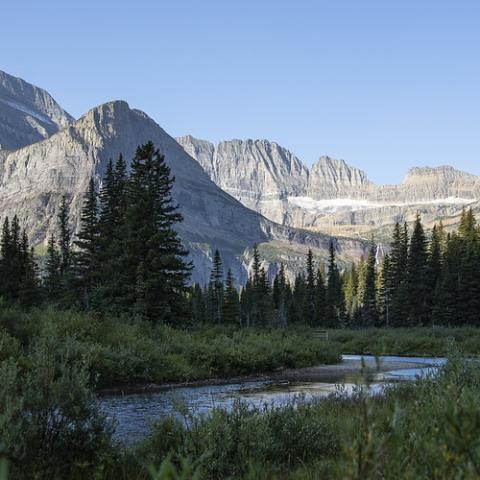A Glacier National Park black bear that connected people with meals has been put down.
Park officials say the bear was first seen on August 31 feeding on mountain ash berries near buildings in the Lake McDonald Lodge developed area. Over the next ten days, however, the bear became increasingly human-habituated despite repeated attempts by park rangers to haze it away from the area with rubber bullets and bean bag rounds.
Habituated bears are bears that have become accustomed to frequenting developed areas, backcountry campgrounds, trails or roadsides, but have retained their natural foraging behavior. They are not necessarily overly familiar with humans, but are comfortable in the presence of humans. On September 10th, after the bear was observed peering into windows at the employee dorm, park staff captured and tagged the bear, and then relocated it to a remote part of the North Fork.
On September 16th, the bear returned to the Lake McDonald area, where it obtained human food by breaking into a vehicle just north of the lodge. This bear was then determined to be a food-conditioned bear and a potential threat to human safety. Food-conditioned bears are those that have sought and obtained non-natural foods, destroyed property or displayed aggressive, non-defensive, behavior towards humans, and are removed from the wild. Food-conditioned bears are not relocated due to human safety concerns.
Park bear managers followed the bear from the location of the damaged vehicle to the mouth of McDonald Creek where it was then destroyed. This action is consistent with Glacier National Park's Bear Management Plan. The male bear was approximately 5 years old, was in good physical condition, and weighed 200 pounds.
Black bears are not good candidates for animal capture facilities, such as zoos and animal parks, due to the plentiful nature of the species throughout the United States.
At this time of year, bears are entering a phase called hyperphagia. It is a period of concentrated feeding to prepare for hibernation. There has been a shortage of berries in many areas of the park this year, leading to the potential for increased bear activity in visitor use areas. Thus it is especially important that visitors keep campgrounds and developed areas clean and free of food and trash. Regulations require that all edibles, food containers, and cookware be stored in a hard-sided vehicle or food locker when not in use, day or night. Place all trash in bear-proof containers. Do not burn waste in fire rings or leave litter around your camp. Fire rings should be free of trash before leaving a campsite.
If you see a bear along the road, please do not stop. Stopping and watching roadside bears will likely start a "bear jam" as other motorists follow your lead. "Bear jams" are hazardous to both people and bears as visibility is reduced and bears may feel threatened by the congestion. Roadside bears quickly become habituated to vehicles and people, increasing their chances of being hit by motor vehicles. Report all bear sightings to the nearest ranger.




 Support Essential Coverage of Essential Places
Support Essential Coverage of Essential Places







Comments
Why not set up feeding stations in locations (away from human activity) where bears would normally find berries etc.? It would supplement in times of low berry production & help prevent the bears 'intrusion' into populated areas.
This sad tale highlights some important concerns of managing the interface of people and wildlife in the parks. A bear or other wildlife that seems docile or even "tame" around humans is still fundementally a wild animal and should be treated with respect and caution. The more we intrude on wildlife habitat the greater the possibility of unfortunate conflicts taking place. This is especially true when nature does not produce sufficient edible resources critical to their needs. All natural systems go through cycles of productivity. In the case of bears this can be when berries or salmon are not available in the quantities necessary to prepare them for a long winter of semi-hibernation. When this happens affected bears may become desperate to find food and will go to whatever lengths necessary to feed themselves. They will also be under extreme stress and likely far less tolerant of human presence.
"Why not set up feeding stations in locations (away from human activity) where bears would normally find berries etc.? It would supplement in times of low berry production & help prevent the bears 'intrusion' into populated areas," Anonymous.
One of the prime directives of the National Park Service is, to the degree possible, to manage for "naturally regulated" populations of park wildlife. Nature is sometimes hard resulting in wildlife being severely stressed and even dying due to lack of adequate food or by being attacked by another animal. That is natures way of regulating. There is an understandable temptation to reduce suffering and avoiding possible conflicts with humans by setting out feeding stations, but that would defeat the purposes of the parks. National parks are not zoos without bars where park rangers are "keepers" responsible for making certain that animals are well fed and safe. To the degree possible, the National Park Service should be minimizing human interference with the natural processes in the parks while also providing opportunities for visitors to observe and appreciate nature at work. When a significant conflict does arise between the goals of providing for visitor enjoyment and perpetuating the natural process the NPS is expected. when possible, to chose the natural process.